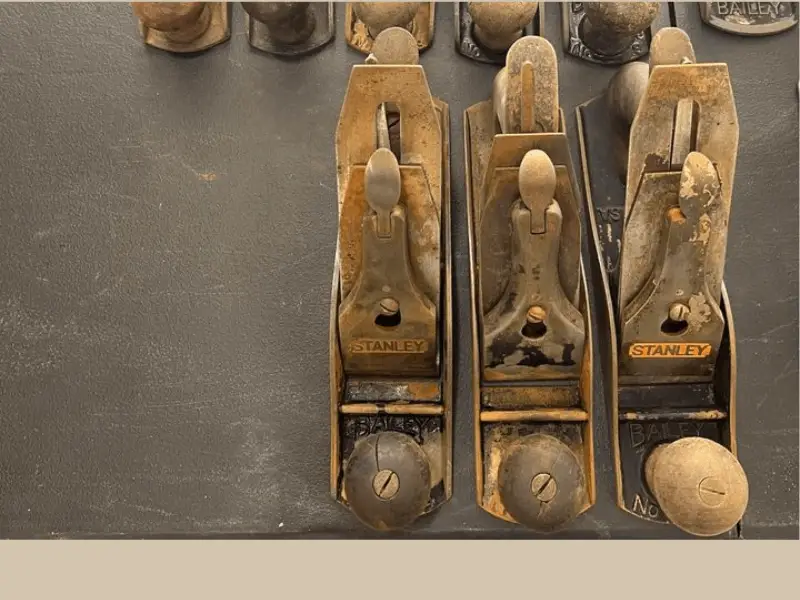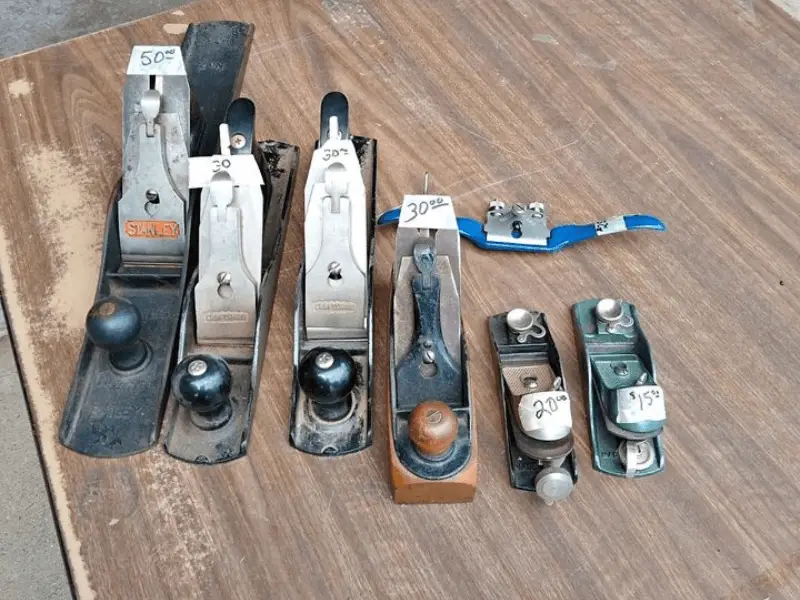Woodworking is a craft that anyone with patience and desire can learn. With creativity and craftsmanship, you can create anything that gives you satisfaction and fulfillment. What you can do with wood is unlimited. However, the secret to finding something fascinating lies in patience and mastery. That involves knowing how to use a combination of various tools and where to use every tool you have.
Old woodworkers were so good at making fascinating pieces from just essential hand tools. One of the oldest tools they were using was the hand plane. Therefore, in our article, we will focus exclusively on hand planes.
Hand planes

As we had said earlier, the hand plane is one of the most ancient hand tools that has passed the test of time regarding the flexibility and control it affords. It is an essential and outstanding hand tool for shaping, smoothing, and finishing wood. For 1500 years, the plane remained relatively unchanged in design. Planes with entirely flat soles for surfacing and edge jointing, molding planes to shape various decorative surfaces, and grooving planes were invested in and used from the Roman period through the Middle Ages and into modern times.
In our article, we have done enough research on hand planes for beginners. Therefore, we walk you through the history of hand planes, help you pick your first set, and suggest the best hand planes.
The History of Hand Planes
Before the Invention of planes
Before the invention of hand planes, the earliest woodworkers had so much difficulty smoothing, paring, and fitting wood. However, the adz could be used in skilled hands to develop a relatively smooth surface. Nevertheless, it was not smooth enough for joining boards with a close fit.
Besides the adz, alternatively, they used the chisels to achieve a flat surface on the wood but with a fine pairing action. However, it took a lot of work to control the cut’s depth and create a flat surface until the plane was developed. The plane applied control to the chisel action to make a fine cut that produced a smooth surface. The control came from allowing only a small portion of the chisel (now usually called a plane or cutting iron) to project through a slot in the plane’s sole. Traditional planes had cutters of wrought iron with steel welded to their cutting edges, hence the name plane iron.
After the Invention of planes
Planes were essential throughout the Middle Ages and up to the 18th century. Joiners or a carpenter’s kit contained several wooden planes:

- A smoothing and longer jointer or jack plane for general work
- A few molding planes
- Some joinery planes, such as a plow and rabbet plane,
In those days, they had fewer planes than we see today. This could be either because of the conservative nature of the artisans of those days or because the tools they had at the time served their purpose. Therefore, many changes during this period needed to be made. However, if there could be any change, it usually just affected the shape of the handle or body of the tool rather than how it could function.
Improvements made on planes
Progressively, many changes started happening in the 18th century. The demand for change started taking effect when rising wealth and a growing middle class with a taste for fine furniture called for more skilled craftsmanship. Therefore, as a result, the request for more up-to-date tools, especially planes, to make quality furniture would be addressed.
The need for fancy molding planes for house trim and casework also arose for joiners and cabinetmakers. Additionally, others required bench planes for sizing and shaping, while heavier smoothing planes were requested for working around tough timber. In the long run, more accurate planes for cutting joinery, raising panels, and making grooves were also required.
Fortunately, because of scientific and mechanical curiosity encouraged by the industrial revolution and the Civil War, things could have remained unchanged. Therefore, even though water and steam-powered factories turned out millions of wooden planes, other inventors and small-town mechanics improved ways to make planes easier to use. That is when they created new adjusters in the plane and better mechanisms for holding the iron in place, and they began to use cast iron for longer-wearing soles.
All the credit goes to Leonard Bailey, Stanley Rule, and Level. They were the godfathers of the changes we see in planes today. They worked hard to transform the simple plane into a classic tool. Therefore, the hand plane continues to hold its place as a vital tool in woodworking even after the invention of the machine that replaces hand craftsmanship. Nevertheless, whether you are a professional or a beginner, mastering a hand plane can take your woodworking skills to the next level. As they say, old is gold, and this certainly holds for the hand plane!
Picking your set

It can be overwhelming for beginners to pick the best set of planes. With so many options on the market, it’s essential to understand the different types and their uses to make an informed decision.
Since the early days, we have been categorizing planes into three broad groups: molding planes, bench planes, and particular types, of which there are many.
The general class of molding planes includes planes with a wide range of cutting surfaces intended to create decorative wooden shapes for cabinetmaking and the exterior and interior joinery of buildings.
On the other hand, the bench plane was for surfacing and edge planing of wood held in a
vice or temporarily fastened on top of a workbench. American wooden and
Iron bench planes varied in size according to function.
We also have a block plane, the baby brother, on the bench plane; we, therefore, use the block plane for more minor, more precise work. It is advantageous to other planes because it is smaller, which makes it perfect for end-grain work and getting into those hard-to-reach corners. It is easier for one-handed use.
Best Hand Plane For Beginners
One of the best hand planes on the market is the WoodRiver #4 Bench Plane, V3. This hand plane was designed to provide years of reliable service to woodworkers courtesy of high-quality materials and durable construction.
Because It is modeled after the Bedrocks, Stanley Tool’s very best line, it has less chance of vibration while hand-planing a board. This is the most essential feature of the plane. This plane style also features a more straightforward mechanism for opening and closing the mouth, using adjustment screws on the frog’s rear without unscrewing the frog, as you do on the Bailey-style planes.
This hand plane features a precision-ground blade, allowing smooth and efficient cutting of wood surfaces. Its adjustable mouth provides even more precision. Therefore, getting a perfect finish on your projects is easier with this plane.
Last but not least, when it comes to comfort, it is top-notch. It comes equipped with lightly finished Bulinga handles, making it efficient for long hours. Therefore, it is a superior plan, no matter the size of the project you are working on. It will produce a smooth and clean surface. Therefore, consider purchasing it and seeing for yourself.
Built with extra-thick 3/16-inch A2 steel for high performance and superior edge retention, this low-angle Sweetheart Jack Plane is what is needed when preparing rough-sawn boards and timbers. It would be best to have a big plane for sizing and preparing stock.
Sometimes, you will find rough-sawn boards and timbers, and we expect you to make them smooth. It would be best to have a big plane for sizing and preparing stock for this case. A jackplane is among the best planes for this purpose since they are hard and are general-purpose planes.
Therefore, looking at the different brands of jack planes on the market, the Stanley 1-12-137 62-Low Angle Sweetheart Jack Plane might be what you need. The hand plane is also suitable for intermediate woodworkers; therefore, it is the ideal place for anyone looking to take their woodworking to the next level.
One of the most notable features of the Low-Angle Sweetheart Jack Plane is its low-angle blade. The feature makes it an excellent tool for planning end-grain and quickly cutting through complex grains. For comfortability in extended use, the sweetheart handle provides a comfortable grip that offers greater leverage for control during planning.
The plane is built with extra-thick 3/16-inch A2 steel for high performance and superior edge retention. They also make durable cast iron, intended to last years without issues. Finally, the precision-ground blade and adjustable mouth also ensure precise control over the cutting action, making it easy to create a smooth surface. Therefore, considering everything, the Stanley 62-Low Angle Sweetheart Jack Plane is ideal for any woodworker.
It is perfect, especially for those who need a hand plane that is versatile, easy to use, and designed to last. It is also a good choice for intermediate woodworkers who want to take their woodworking to the next level and achieve professional results. Therefore, this is the perfect place for delivering excellent results.
Conclusion
Since hand planes have been around for many years, we can fully bet on the credibility of this ancient tool. Therefore, choosing a plane that will fit your needs in the long run is up to you. Always select a reliable plane to create a perfect finish for your projects.
Frequently Asked Questions about Hand Planes
What are the different types of hand planes?
There are many varieties of hand planes, but let’s try to make it easy to understand. We categorize them by the task they perform.

Types of Hand Plane Basic Task
| Types of Hand plane | Basic Task |
| jack plane | sizing and preparing stock |
| joinery planes | cutting joinery |
| block planes | flattening surface to a smooth polish |
| spokeshave for shaping compass plane for cutting along curves Panel-raising planes Chamfer planes Molding planes | decoration and shaping |
What size plane should I use?
The planes you will use the most are the No. 3 or 4 smoothing plane, the No. 5 jack plane, and the No. 7 or 8 jointer plane. The No. 4, however, is a shop workhorse that touches almost every surface. It can maintain a flat surface and leave a perfect cut, and it does it quickly. Additionally, it can square and bevel edges and shape convex surfaces. However, if the length and width of a workpiece exceed those of No. 4, No. 7 can get the work done.
How do I sharpen a hand plane blade?
For proper sharpening, use a honing guide. With a honing guide, you can maintain the correct angle when sharpening the blade on a sharpening stone. You can also use a sharpening jig to ensure a consistent edge, especially on a glinder.
How do I adjust the depth of the cut?
On all hand planes, you control the depth of a cut by turning the adjustment knob. The knob usually moves the blade up or down. For the correct depth, you can start by adjusting the knob so that the cutting iron projects by about 0.5 mm. From there, you start planning as you re-adjust the depth to achieve a clean,slightly transparent shaving. I suggest that you test the amount on a scrap piece of wood before making a final pass on the actual piece.
How do I maintain my hand plane?
Follow these steps to ensure good working order on all your planes:
1. Make sure you keep it clean and oily after use
2. Always store the tools in a dry place. Moisture and extreme temperatures damage your tools.
3. Ensure that you sharpen the blade regularly. Additionally,when the need arises,replacements are also accepted.


